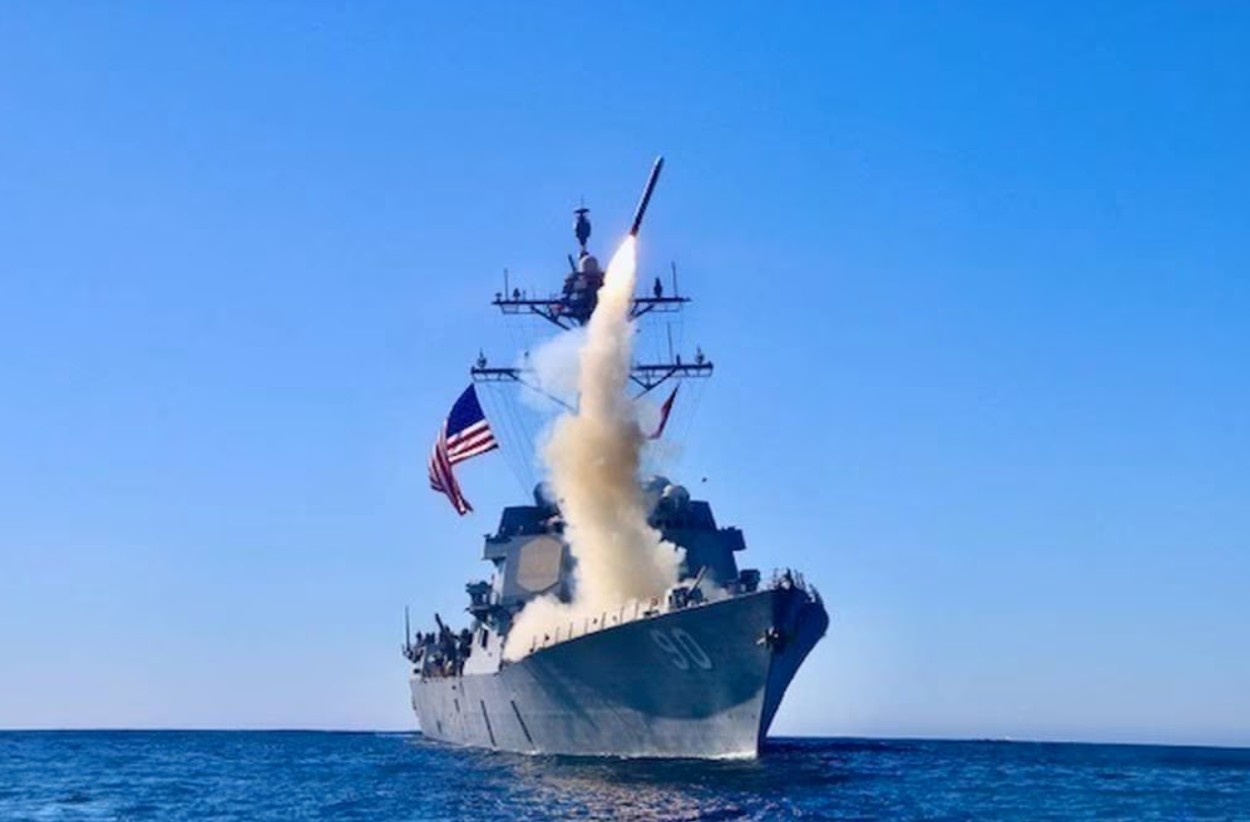The three-year-old Russia-Ukraine War is entering a new, dangerous phase, with the Kremlin once again raising the nuclear spectre as the US plays with the idea of supplying the nuclear-capable long-range Tomahawk missiles to Ukraine, a situation eerily similar to the 1962 Cuban missile crisis, when the world came to the brink of a nuclear armageddon.
Former Russian president and the Deputy Chairman of the Security Council of the Russian Federation Dmitry Medvedev has issued a stark warning, saying U.S. plans to supply Tomahawk cruise missiles to Ukraine could “end badly for everyone, especially Trump.”
Medvedev wrote on Russia’s Max national messenger that the potential shipment of Tomahawk missiles to Kiev would do no good to anyone.
He emphasized that it’s impossible to determine if a flying Tomahawk missile was carrying nuclear weapons or conventional ones, which had been stressed repeatedly.
“The supply of these missiles could end badly for everyone. First and foremost for Trump,” Medvedev wrote.
“It’s not Banderite Kiev but the US that will carry out launches,” he added.
Meanwhile, Kremlin Spokesman Dmitry Peskov told reporters that launching Tomahawk missiles would require the involvement of US personnel, so the potential delivery of such missiles to Kiev could have serious consequences.
“The handling of such sophisticated missiles would inevitably require the involvement of American specialists. That’s an evident fact,” he said.
The strong remarks by the Kremlin follow U.S. President Donald Trump’s statement that he may provide Kyiv with long-range Tomahawks if Vladimir Putin refuses to end the war in Ukraine.
“The United States would not sell missiles directly to Ukraine, but provide them to NATO, which can then offer them to the Ukrainians. Yeah, I might tell him (Russian President Vladimir Putin), if the war is not settled, we may very well do it. We may not, but we may do it. Do they want to have Tomahawks going in their direction? I don’t think so,” Trump said.
Meanwhile, Ukrainian President Volodymyr Zelenskyy assured President Trump in a phone call on October 13 that Kyiv will use long-range Tomahawk missiles only against Russian military targets.
The nuclear rabble-rousing over the US supplying Tomahawk missiles to Ukraine is reminiscent of the 1962 Cuban Missile Crisis, when the US and the Soviet Union almost started a nuclear war over the issue of the Kremlin supplying nuclear-capable ballistic missiles to Havana.
In fact, there are more than passing similarities between the two situations. In 1962, the US objected to the fact that Cuba was just around 90 miles from Florida. Similarly, Moscow is underlining that the US is supplying long-range nuclear-capable missiles to a country that not only shares a border with Russia but is also at war with Russia.
Notably, Russia has already modified its nuclear doctrine. In November last year, Kremlin spokesperson Dmitry Peskov told journalists that new changes to Russia’s nuclear weapons doctrine signed by President Vladimir Putin mean “the use of Western non-nuclear rockets by the Armed Forces of Ukraine against Russia can prompt a nuclear response.”
So, the use of US-supplied Tomahawk missiles by Ukraine against Russia crosses the nuclear threshold of Moscow. But is there a realistic chance of Moscow using nuclear weapons due to Tomahawk missiles?
What Are Tomahawk Missiles
The Tomahawk is an intermediate-range (2,500 km or 1,550 miles), subsonic cruise missile that is launched from U.S. Navy ships and submarines.
It provides Ukraine with a long-range, deep-strike capability to hit deep inside Russia. The Tomahawk can carry either conventional or nuclear payloads.
The missile measures 20 feet (6.1 meters) long with an 8.5-foot wingspan, and weighs about 1,510 kg. It can carry a payload of 454 kg. Each missile costs around USD 1.3 million.
The Tomahawk was designed to fly at subsonic speed while maintaining a low altitude, making it difficult to detect on radar. It uses tailored guidance systems to maneuver while at such low elevations.
The Tomahawk was first deployed in combat during the 1991 Gulf War, Operation Desert Storm.

Later, the missile was also used in 2003’s Operation Iraqi Freedom. It also achieved combat success in Afghanistan, Somalia, Libya, and Syria.
Most recently, the missile was used against Houthi targets in Yemen and to hit Iran’s nuclear site.
Tomahawk Variants
Since its creation, numerous variants of the Tomahawk have been produced.
According to the Missile Threat, the Block I versions included the Tomahawk Land Attack Missile-Nuclear (TLAM-N, TLAM-A, RGM/UGM-109A) and the Tomahawk Anti-Ship Missile (TASM, RGM/UGM-109B).
Block II variants include the TLAM-C (RGM/UGM-109C), designed to attack hardened targets, and the TLAM-D (RGM/UGM-109D), designed to attack ‘soft’ targets such as aircraft and troop concentrations.
Block III updates included new electronics allowing for coordinated attacks.
Block IV missiles, the most modern version, are capable of loitering in flight for hours and possess a two-way datalink designed for receiving updated mission information and course corrections.
Can Russia Use Nuclear Weapons?
According to Russia’s latest nuclear doctrine, Moscow could use nuclear weapons if the Armed Forces of Ukraine attack Russia with “Western non-nuclear rockets”.
According to this doctrine, the use of US-supplied Tomahawk missiles by Ukrainian armed forces will cross Moscow’s nuclear threshold.
However, it must be noted that Russia changed its nuclear policy in November last year, when the former US President Joe Biden allowed Ukraine to launch long-range strikes in mainland Russia.
Till then, the Kremlin has maintained that allowing Ukraine to strike at mainland Russia with Western weapons is a red line for Moscow, and it would not hesitate to launch nuclear weapons in response.
At that time, the main issue was allowing Ukraine to strike inside Russia using US-made ATACMS and UK/France-supplied Storm Shadow missiles.
However, since then, Ukraine has used ATACMS and Storm Shadow missiles against Russia multiple times, without eliciting a nuclear response from Moscow.
Russia’s objection that Moscow can not be sure whether the Tomahawk missiles are carrying a conventional payload or a nuclear payload is also a red herring, as Ukraine has no nuclear warheads.

Furthermore, the ATACMS and the Storm Shadow missiles, launched multiple times by Ukraine, are also nuclear-capable. If Moscow did not resort to nuclear strikes on the use of ATACMS and Storm Shadow, there is no reason to believe that the Kremlin would fall back on its nuclear arsenal in case Ukraine launches Tomahawks.
Russia also made similar noises when US-made F-16 and French-made Mirage-2000 fighter jets were delivered to Ukraine. Both these fighter jets can launch nuclear weapons.
At that time, Russia’s foreign minister Sergei Lavrov said that US-built F-16 fighter jets can ‘accommodate’ nuclear weapons and warned that supplying Kyiv with them would escalate the conflict further.
“We must keep in mind that one of the modifications of the F-16 can ‘accommodate’ nuclear weapons,” Lavrov said in a speech at a military base in Dushanbe, Tajikistan.
These precedents in the Russia-Ukraine War show that while the supply of Tomahawk missiles would mark a dangerous escalation in the three-year-old war, their use is unlikely to lead to a nuclear armageddon.
At the same time, while the supply of these missiles would hurt Moscow, they are unlikely to change the battlefield dynamics substantially, as earlier ATACMS, Storm Shadows, F-16s, and Mirage-2000 fighter jets could not dramatically alter the situation on the ground.
While Russia is raising the nuclear spectre, most likely Moscow would respond to this escalation by supplying US adversaries, such as Iran and North Korea, with higher threshold weapons.
- Sumit Ahlawat has over a decade of experience in news media. He has worked with Press Trust of India, Times Now, Zee News, Economic Times, and Microsoft News. He holds a Master’s Degree in International Media and Modern History from the University of Sheffield, UK.
- VIEWS PERSONAL OF THE AUTHOR.
- He can be reached at ahlawat.sumit85 (at) gmail.com




